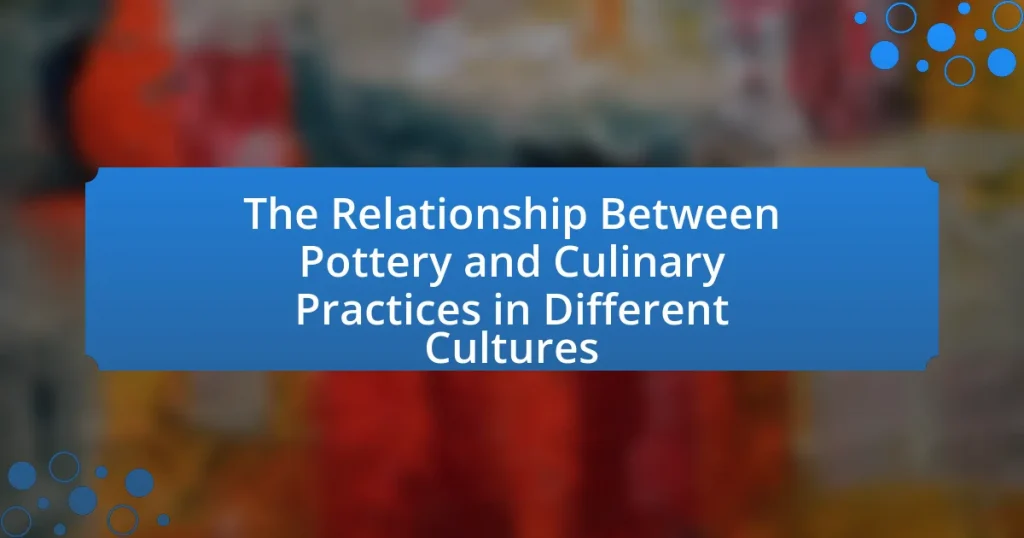The article explores the intricate relationship between pottery and culinary practices across various cultures, highlighting how pottery serves as a vital medium for cooking, serving, and storing food. It examines the historical significance of pottery, its influence on culinary techniques, and the types of pottery commonly used in different regions. The article also discusses how pottery reflects cultural identity, communal dining experiences, and the evolution of cooking methods, while addressing modern trends in sustainable pottery production and the incorporation of traditional pottery by contemporary chefs. Key insights include the impact of pottery materials on flavor and texture, as well as practical tips for enhancing culinary practices with pottery.

What is the relationship between pottery and culinary practices in different cultures?
Pottery serves as a fundamental medium for culinary practices across various cultures, facilitating cooking, serving, and storage of food. Different cultures utilize pottery to reflect their unique culinary traditions, as seen in the use of clay pots in Mediterranean cooking for slow-cooking stews, which enhances flavor through even heat distribution. Additionally, in East Asian cultures, pottery is integral for tea ceremonies, where specific teapots are designed to optimize the brewing process, showcasing the relationship between the vessel and the culinary experience. Historical evidence indicates that pottery has been used for over 20,000 years, with archaeological findings revealing its role in food preparation and consumption, thus underscoring its significance in shaping culinary practices globally.
How has pottery influenced culinary practices across various cultures?
Pottery has significantly influenced culinary practices across various cultures by providing functional and aesthetic vessels for cooking, serving, and storing food. In ancient civilizations, such as the Greeks and Romans, pottery allowed for the development of specialized cooking techniques, including baking and boiling, as clay pots could withstand high temperatures. Additionally, the use of pottery for food storage improved preservation methods, enabling communities to store grains and liquids, which facilitated trade and food security. Archaeological findings, such as the discovery of pottery shards in Mesopotamia dating back to 3500 BCE, demonstrate the integral role of pottery in daily life and culinary practices, highlighting its impact on food preparation and consumption across different cultures.
What types of pottery are commonly used in culinary practices?
Common types of pottery used in culinary practices include earthenware, stoneware, and porcelain. Earthenware is often utilized for baking and cooking due to its ability to retain heat, while stoneware is favored for its durability and resistance to chipping, making it suitable for both cooking and serving. Porcelain, known for its non-porous nature, is commonly used for fine dining and serving dishes. These pottery types have historical significance; for instance, earthenware has been used since ancient times for cooking in various cultures, demonstrating its longstanding role in culinary practices.
How do different materials used in pottery affect cooking methods?
Different materials used in pottery significantly affect cooking methods due to their thermal properties and reactivity. For instance, clay pottery retains heat well, allowing for slow cooking and even heat distribution, which is ideal for stews and braises. In contrast, stoneware is more durable and can withstand higher temperatures, making it suitable for baking and roasting. Additionally, materials like earthenware can react with acidic foods, altering flavors, while non-reactive materials like porcelain do not affect the taste of the food. Historical evidence shows that cultures utilizing clay pots for cooking have developed techniques that maximize the benefits of these materials, such as the use of pit cooking in Native American traditions, which relies on the heat retention of clay.
Why is pottery significant in the context of cultural identity and cuisine?
Pottery is significant in the context of cultural identity and cuisine because it serves as a tangible representation of cultural heritage and culinary practices. Various cultures utilize distinct pottery styles and techniques that reflect their historical, social, and environmental contexts. For instance, the use of specific clay types and firing methods can indicate a community’s geographical location and available resources, while decorative motifs often convey cultural narratives and values. Additionally, pottery shapes and sizes are designed to accommodate traditional cooking and serving methods, influencing how food is prepared and consumed. This relationship is evident in cultures such as the Pueblo people of the American Southwest, who create pottery that is not only functional for cooking but also embodies their spiritual beliefs and artistic expressions. Thus, pottery acts as a crucial link between cultural identity and culinary practices, illustrating how food and tradition are interwoven.
How does pottery reflect the history and traditions of a culture?
Pottery reflects the history and traditions of a culture by serving as a tangible representation of its artistic, functional, and social practices. For instance, the styles, materials, and techniques used in pottery can indicate the technological advancements and resource availability of a society, such as the use of specific clay types or glazing methods that evolved over time. Additionally, pottery often features motifs and designs that are culturally significant, illustrating beliefs, rituals, and daily life, as seen in the intricate patterns of Native American pottery that convey stories and heritage. Archaeological findings, such as the discovery of ancient pottery shards, provide insights into trade routes, dietary habits, and social structures, thereby reinforcing the connection between pottery and cultural identity.
What role does pottery play in communal and family dining experiences?
Pottery serves a crucial role in communal and family dining experiences by providing functional and aesthetic vessels for serving and sharing food. These ceramic dishes and containers enhance the presentation of meals, fostering a sense of togetherness and cultural identity during shared meals. For instance, in many cultures, traditional pottery is used to serve specific dishes, reinforcing communal bonds and rituals associated with dining. Historical evidence shows that pottery has been used for thousands of years across various cultures, such as the use of clay pots in Mediterranean societies for communal feasting, which emphasizes the importance of shared culinary experiences in strengthening family and community ties.
What are the historical developments of pottery in relation to food preparation?
The historical developments of pottery in relation to food preparation began around 20,000 years ago with the creation of the earliest ceramic vessels, which allowed for the cooking and storage of food. These early pots, made from clay and fired in kilns, enabled various cultures to boil, bake, and store food, significantly enhancing their culinary practices. For instance, the Jomon culture in Japan produced some of the oldest known pottery, dating back to 14,000 BCE, which was used for cooking and food storage, demonstrating the integral role of pottery in food preparation. Additionally, the advent of pottery in ancient Mesopotamia around 3500 BCE facilitated the development of more complex cooking techniques and food preservation methods, as these vessels could withstand higher temperatures and were more durable than previous materials. This evolution of pottery not only improved food preparation but also influenced social structures, trade, and cultural exchanges among different civilizations.
How did ancient civilizations utilize pottery for cooking and serving food?
Ancient civilizations utilized pottery for cooking and serving food by creating various forms of ceramic vessels designed for specific culinary tasks. These vessels, such as pots, bowls, and plates, were essential for boiling, baking, and serving food, allowing for efficient heat retention and distribution. For example, the use of clay pots in Mesopotamia enabled the slow cooking of stews over open flames, while the Greeks developed amphorae for storing and serving liquids like oil and wine. Archaeological findings, such as the discovery of pottery shards in ancient kitchen sites, confirm that these artifacts were integral to daily food preparation and consumption practices across cultures, highlighting their role in enhancing culinary techniques and social dining experiences.
What innovations in pottery have emerged alongside culinary advancements?
Innovations in pottery that have emerged alongside culinary advancements include the development of non-stick glazes, microwave-safe ceramics, and multifunctional cookware. Non-stick glazes enhance cooking efficiency and ease of cleaning, reflecting the demand for convenience in modern culinary practices. Microwave-safe ceramics allow for quick meal preparation, catering to fast-paced lifestyles. Additionally, multifunctional cookware, such as pots that can be used on the stovetop and in the oven, demonstrates the integration of culinary techniques with pottery design. These innovations are a direct response to evolving cooking methods and consumer preferences, showcasing the dynamic relationship between pottery and culinary advancements.
How do pottery styles vary across different regions and their culinary practices?
Pottery styles vary significantly across different regions, reflecting local culinary practices and cultural traditions. For instance, in Japan, the use of earthenware such as Raku pottery is closely tied to the tea ceremony, emphasizing aesthetics and functionality for serving tea. In contrast, Mexican pottery often features vibrant colors and intricate designs, which are used for serving traditional dishes like mole and tamales, showcasing the importance of presentation in their culinary culture. Additionally, Mediterranean pottery, such as terracotta, is designed for cooking and serving dishes like stews and casseroles, highlighting the communal aspect of dining in these cultures. These variations illustrate how pottery not only serves practical purposes but also embodies the culinary identity and heritage of each region.
What are the connections between pottery design and specific cooking techniques?
Pottery design is intrinsically connected to specific cooking techniques, as the shape, material, and surface treatment of pottery influence heat retention, cooking time, and flavor development. For example, earthenware pots are often used for slow cooking methods like braising due to their ability to retain moisture and distribute heat evenly, which enhances the flavors of stews and soups. Additionally, the design of pottery, such as the presence of a wide mouth or narrow neck, can affect the evaporation rate during cooking, impacting the final texture and taste of the dish. Historical evidence shows that cultures such as the Japanese utilize specific pottery styles, like donabe, for steaming rice, which relies on the pot’s design to create the ideal cooking environment.
What specific culinary practices are associated with pottery in various cultures?
Specific culinary practices associated with pottery in various cultures include cooking, serving, and storing food. For instance, in ancient Greece, clay pots were used for baking bread and cooking stews, while in Japan, earthenware pots known as “donabe” are utilized for simmering dishes like hot pot. Additionally, in Mexican culture, “comales” are flat clay griddles used for cooking tortillas, demonstrating the integral role of pottery in food preparation. These practices highlight how pottery not only serves functional purposes but also reflects cultural identity and culinary traditions across different societies.
How do different cooking vessels impact the flavor and texture of food?
Different cooking vessels significantly impact the flavor and texture of food due to their material properties and heat conduction characteristics. For instance, cast iron retains heat well and can create a crispy texture in foods like cornbread, while stainless steel, which heats quickly, may not provide the same depth of flavor due to its inability to retain heat as effectively. Additionally, clay pots allow for slow cooking and moisture retention, enhancing the flavors of stews and soups through even heat distribution. Research indicates that the use of traditional pottery in various cultures, such as Mexican or Indian cooking, contributes to unique flavor profiles due to the porous nature of the clay, which can absorb and impart flavors over time.
What are the traditional dishes that require specific types of pottery?
Traditional dishes that require specific types of pottery include tagine from Morocco, which is cooked in a conical clay pot designed for slow cooking, and cazuela from Spain, which is made in earthenware that retains heat well. The tagine pot’s unique shape allows for moisture retention, enhancing the flavors of the dish, while the cazuela’s material is ideal for even heat distribution, making it perfect for stews and casseroles. These pottery types are integral to the cooking process, as they influence the texture and taste of the food, demonstrating the deep connection between culinary practices and pottery in various cultures.
What are the modern trends in pottery and culinary practices?
Modern trends in pottery and culinary practices emphasize sustainability, personalization, and the integration of technology. Pottery is increasingly being made from eco-friendly materials, reflecting a growing consumer preference for sustainable products. Additionally, artisans are focusing on unique, handcrafted designs that cater to individual tastes, allowing for a more personalized dining experience. In culinary practices, there is a notable rise in the use of artisanal pottery for serving and cooking, which enhances the aesthetic appeal of food presentation. This trend is supported by the increasing popularity of social media platforms, where visually appealing dishes served in distinctive pottery gain traction. Furthermore, technology plays a role, with innovations in pottery-making techniques and the use of smart kitchenware that combines traditional craftsmanship with modern functionality.
How are contemporary chefs incorporating traditional pottery into their cooking?
Contemporary chefs are incorporating traditional pottery into their cooking by using handcrafted ceramic vessels for both cooking and serving, which enhances the aesthetic and sensory experience of the meal. This practice not only preserves cultural heritage but also improves the flavor profile of dishes, as certain types of pottery can enhance heat retention and distribution. For example, chefs often utilize clay pots for slow-cooking methods, which allow for even cooking and moisture retention, resulting in richer flavors. Additionally, the use of traditional pottery in plating emphasizes the connection between food and culture, as seen in various culinary traditions around the world, such as Moroccan tagines or Japanese donabe. These practices reflect a growing trend among chefs to honor historical cooking methods while creating innovative dining experiences.
What sustainable practices are emerging in pottery production for culinary use?
Sustainable practices emerging in pottery production for culinary use include the use of locally sourced clay, energy-efficient kilns, and non-toxic glazes. Local clay minimizes transportation emissions and supports regional economies, while energy-efficient kilns reduce fossil fuel consumption during firing. Additionally, non-toxic glazes ensure that pottery is safe for food use and environmentally friendly, as they avoid harmful chemicals. These practices reflect a growing awareness of environmental impact and health considerations in culinary pottery production.
What practical tips can enhance the use of pottery in culinary practices?
Using pottery in culinary practices can be enhanced by selecting the appropriate type of pottery for specific cooking methods. For instance, earthenware is ideal for slow cooking and stews due to its ability to retain heat, while stoneware is suitable for baking because of its durability and even heat distribution. Additionally, pre-soaking clay pots before use can prevent cracking and improve heat retention, as demonstrated by traditional cooking methods in various cultures, such as Moroccan tagines. Furthermore, seasoning pottery, like cast iron, can enhance flavor and create a non-stick surface, which is supported by culinary practices in regions that utilize clay cookware extensively.


